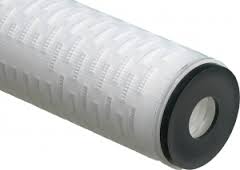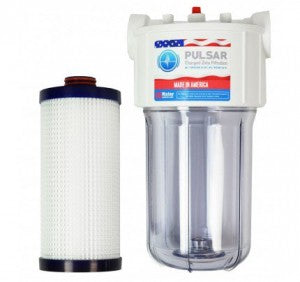Pulsar Disruptor Filter - A Game Changer
New Pulsar™ Disruptor® Filter with Ahlstrom Media

The Pulsar Disruptor Filter is a disruptive technology, in that it displaces an established technology and shakes up the industry or a ground-breaking product that creates a completely new industry. When the PC replaced the typewriter, it forever changed the way we work and communicate. Cell phones were “disruptive technology” because it allowed us to communicate from almost anywhere and the Pulsar Disruptor Filter System is “disruptive technology” in that a filter system can now reduce or remove the following contaminants:
- Bacteria
- Iron
- Virus
- Copper
- Cysts
- Lead
- Tannin
- Chromium VI
- Endotoxins
- Selenium
- Legeonella
- Tannic Acid
- Silica
- Humic Acid
- Heavy Metals
- Cryptosporidium
- Fulvic Acids
The Pulsar Disruptor filter is manufactured with Nano Alumina Fibers that have a Zeta potential of 51 millivolts. A CZF cartridge retains bacteria, virus, cryptosporidium oocysts and even tannin with its strong Zeta Potential. To removes cysts and bacteria. Unlike mechanical filters which rely on “pore size” the Charged Zeta Technology literally “secures” the contaminant. It is “absorbed” in a very real way. The filters have a long life and are easily replaceable. The Pulsar Disruptor filter media is manufactured from a naturally occurring element called boehmite, which has no known Health Side Effects. In fact, boehmite has long been used as an additive to food products and digestive analgesics. Additionally, it has passed testing for NSF/ANSI Standard 42 and 61 for potable water and USP Class VI testing and endotoxin testing. Pulsar Disruptor filter media is engineered with this 51 millivolt charge covering the entire volume and depth of the media. A Pulsar Disruptor filter accomplishes submicron filtration with a “charge” rather than “pore size” filtration, which allows for virtually zero pressure drop and high flow rates. If you compare the Pulsar Disruptor filter to “ultrafiltration” membranes, you will find dramatically higher flow rates with less pressure drop. In summary, with the Pulsar Disruptor filter, you get the following:
- High efficiency reduction
- Electroadsorptivereduction of virus
- Electroadsorptive and mechanical reduction of bacteria and endotoxin
- Mechanical removal of cysts
- Higher flow rates and lower pressure drop than membranes

DOE or SOE Filter Cartridge However, the filter choices and performance often depends upon on the seal integrity within the filter vessel. Double Open End (DOE) or Single Open End (SOE) gasket cartridges on some brands of cartridges may have very high efficiency capability but their reliance on a “knife” or pressure seal may not maintain a positive seal sufficient to stop the migration of microbial contaminants due to pressure shifting or pulsations changes from varying flow rates, which can break the seal! Without a proper seal, microbial contamination is likely to occur right from the start. Cartridges using a knife or pressure seal do not have the tolerances sufficient to act as a microbial barrier.

Pulsar Disruptor Filter with 222 Filter Seal Filter cartridges with a double O-ring seal such as a 222 or 226 (or similar design) that fit into a receiver, within the element vessel, and that provides an O-ring compression necessary to prevent by-pass are the type of filters that should be used. The Pulsar Disruptor Electro-adsorptive technology is now available at US Water Systems, and it does not rely on pore size exclusion for high levels of microbial reduction. It also does not release the retained contaminants in an event of an integrity breach. The electro-positive charge captures and retains contaminants throughout the depth of the pore structure. This method reduces microbes via adsorption + mechanical filtration not simply pore size exclusion. The electro-adsorptive charge provides a net adsorption efficiency of ~.002 um and mechanically with a mean pore size of approximately 1.2 microns. The charge field removes the negatively charged, submicron particles while larger particles are captured within the fiber structure of the media. This method reduces virus by > 4 LRV with a mechanical mean pore size of approximately 1.2 microns. Electro-adsorption provides “retention” of the organisms through these charged structures within the media and small integrity breaches, which may occur, does not produce a catastrophic release of organisms. Mechanical pore dependent membranes and filters do not enjoy this benefit. This filter media has over 400 layers of pore depth created by a wet laid non-woven manufacturing process. This results in a media having a torturous flow pattern, high flow rates at low pressure drop. The charge field results in a high initial removal efficiency as well as high loading capacity. This results in high energy saving. This media has been sold commercially for years with great results. When used with appropriate and proper pre-filtration for particulates, it provides efficient life cycles between cartridge changes. While the media performance is excellent it still requires good manufacturing practices and the integrity of the finished product is just as critical as membranes. This media requires manufacturing knowledge and experience as it can be difficult to pleat due to its 1 mm thickness and composite structure. A quality control procedure with 100% NDPT (Non Destructive Performance Test) or reverse bubble testing in alcohol solution is required at the production facility for every cartridge to insure the integrity. Spent elements and cartridges that remove microbes become a bio hazard and without an antimicrobial additive to control these microbes cannot be disposed of as normal waste. This issue is most often overlooked and the elements and cartridges are typically disposed of in the trash. The Pulsar Disruptor filter is manufactured from a naturally occurring element called boehmite, which has no known Health Side Effects. To date, US Water Systems has had excellent success in removing or reducing tannin, lead, silica and chromium 6.






49 Comments
I have a 3-year Koi Pond/Water & Plant garden, 5,000 gallons that has been experiencing “Tea colored water” since the start of the 2nd year and getting worse. It was professionally installed, by a very reputable company and member of our Koi Society, with only a bog-type biological filtration and UV light, no chemical/mechanical filtration, liner bottom and sides with NO gravel. It ranges from 2-4 feet deep however due to the tea color I cannot see more than 12" deep or so, very dark color. Our water supply comes from Naperville City out of Lake Michigan, so it is “out of the tap” very clear and safe for human consumption. However we have many Pine trees and a large River Birch directly around the pond dropping needles/leaves especially in the bog/stream area. Our bog is reverse flow, water coming from skimmers/bottom drain, up through the bog and over the water falls/stream. We make weekly 20% water changes and continually remove any leaves/debris from the bottom with a net. We have a Hydrangea plant, which is supposed to have pink flowers under our normally alkaline soil, that are now turning “blue”, which seems to confirm acid/low PH conditions. Unfortunately there is no way the trees can be removed or anyway to stop pine needles/leaves from entering the bog/stream area. I prefer not to live with this tea colored water and the limitation is has on enjoying the pond.
My pond installer does not believe that using Activated Carbon or other mechanical/chemical filtration will help long-term. We have tried two heavy doses of Potassium Permanganate with little effect. He is now suggesting an Ozone Generator that MAY solve the problem but it costs many thousands of dollars to install with no guarantee of working, just a lot of hope on his part, because of the on-going pollution of pine needles and leaves.
I would certainly appreciate whatever recommendations/information you can provide along with product information about your Charged Membrane filtration systems if you think that will help. I read about your water testing service to determining what type of tannins I might have. Please provide information about how to send you a sample.
I appreciate whatever you can do to help my wife and I enjoy our pond more and getting that “gin crystal clear” water. Thanks in advance and feel free to reply by email.
Jerry Koudelik
Started reading about Charged Zeta Filtration (CZF) and notice the comment about “Pulsar CZF cartridges eliminates staining and scaling”. Does this mean CZF filters traps calcium and magnesium ions to reduce / eliminate scale buildup caused by hard water?
Cannot find any information to confirm or deny the scale reduction for CZF. Appreciate finding more information about the potential for CZF to reduce hard water scaling.
At this juncture, I would not worry about testing for tannin. They simply test for tannin, not type of tannin.
Do you know what the flow rate is on the re-circ line? What size is the line?
Barry,
The only system with a Pulsar Filter that eliminates scaling is this one:
https://www.uswatersystems.com/green-wave-pulsar.html
But it is the Green Wave component that does that, not the Pulsar CZF. The Pulsar removes heavy metals, tannin and the like.
Leave a comment
Please note, comments need to be approved before they are published.